Study on the Influence of Aggregate Roundness of Reclaimed Asphalt Mixture on Its Road Performance
Abstract
:1. Introduction
2. Study on the Roundness Characteristics of Asphalt Mixture Recovery Material
2.1. Acquisition and Definition of Aggregate Roundness Characteristics
2.2. Analysis of Roundness Characteristics of Aggregate of Each Size
3. The Influence of Roundness Characteristics on the Road Performance of Mixture
3.1. Grading Design of Reclaimed Asphalt Mixture
3.2. Effect of Roundness on Low-Temperature Performance
3.3. Effect of Roundness on High-Temperature Performance
3.4. Effect of Roundness on Water Stability Performance
4. Conclusions
Author Contributions
Funding
Data Availability Statement
Conflicts of Interest
References
- Tarsi, G.; Tataranni, P.; Sangiorgi, C. The Challenges of Using Reclaimed Asphalt Pavement for New Asphalt Mixtures: A Review. Materials 2020, 13, 4052. [Google Scholar] [CrossRef] [PubMed]
- Roja, K.L.; Masad, E.; Mogawer, W. Performance and blending evaluation of asphalt mixtures containing reclaimed asphalt pavement. Road Mater. Pavement Des. 2021, 22, 2441–2457. [Google Scholar] [CrossRef]
- Zhou, Z.; Gu, X.; Jiang, J.; Ni, F.; Jiang, Y. Fatigue cracking performance evaluation of laboratory-produced polymer modified asphalt mixture containing reclaimed asphalt pavement material. Constr. Build. Mater. 2019, 216, 379–389. [Google Scholar] [CrossRef]
- Nasim, K.S.; Hasan, N.K.; Khaled, H.H.; Ibrahim, A. Effect of using recycled coarse aggregate and recycled asphalt pavement on the properties of pervious concrete. Struct. Eng. Mech. 2018, 67, 283–290. [Google Scholar]
- Yang, J.; Tao, W.; Gao, J.; Yu, D.; Zhou, J.; He, L.; Yao, Y. Measurement of particle agglomeration and aggregate breakdown of reclaimed asphalt pavement. Constr. Build. Mater. 2021, 296, 123681.1–123681.14. [Google Scholar] [CrossRef]
- Rout, M.K.D.; Sahdeo, S.K.; Biswas, S.; Roy, K. Feasibility Study of Reclaimed Asphalt Pavements (RAP) as Recycled Aggregates Used in Rigid Pavement Construction. Materials 2023, 16, 1504. [Google Scholar] [CrossRef] [PubMed]
- Liu, S.; Xu, Y.; Meng, H. Laboratory evaluation of PE modified asphalt mixture containing reclaimed asphalt pavement. Indian J. Eng. Mater. Sci. 2019, 26, 83–88. [Google Scholar]
- Paluri, Y.; Heeralal, M.; Kumar, P.R. A study on the use of reclaimed asphalt pavement aggregates in pavement quality concrete. Cem. Wapno Beton 2019, 24, 421. [Google Scholar] [CrossRef]
- Poursoltani, M.; Hesami, S. Performance evaluation of microsurfacing mixture containing reclaimed asphalt pavement. Int. J. Pavement Eng. 2020, 21, 1491–1504. [Google Scholar] [CrossRef]
- Peng, G.; Wei, W.; Tang, B.; Yang, F. Evaluation of High-temperature Performance of Asphalt Mixture based on Angularity of Recycled Coarse Aggregate. Highway 2017, 62, 220–225. [Google Scholar]
- Gang, Z. Impact of Morphological Characteristics of Aggregate Particles on High Temperature Performance of Asphalt Mixture. Road Mach. Constr. Mech. 2017, 34, 47–51. [Google Scholar]
- Wang, C. Study on Image Analysis of Aggregate Morphological Features and Mixture Grading; Chang’an University: Xi’an, China, 2011. [Google Scholar]
- Diao, Z. Analysis of Mechanical Properties of Asphalt Mixture Based on Morphological Characteristic Parameters of Coarse Aggregate; Jilin University: Changchun, China, 2020. [Google Scholar]
- Liu, Y.; Huang, Y.; Sun, W.; Nair, H.; Lane, D.S.; Wang, L. Effect of coarse aggregate morphology on the mechanical properties of stone matrix asphalt. Constr. Build. Mater. 2017, 152, 48–56. [Google Scholar] [CrossRef]
- Aragão, F.T.S.; Pazos, A.R.G.; da Motta, L.M.G.; Kim, Y.-R.; Nascimento, L.A.H.D. Effects of morphological characteristics of aggregate particles on the mechanical behavior of bituminous paving mixtures. Constr. Build. Mater. 2016, 123, 444–453. [Google Scholar] [CrossRef]
- Yingning, B.; Sheng, B. Experimental Study on the Influence of Coarse Aggregate Characteristics on the Skid Resistance Of Asphalt Pavement; Yunnan Provincial Transportation Planning and Design and Research Institute: Kunming, China, 2016. [Google Scholar]

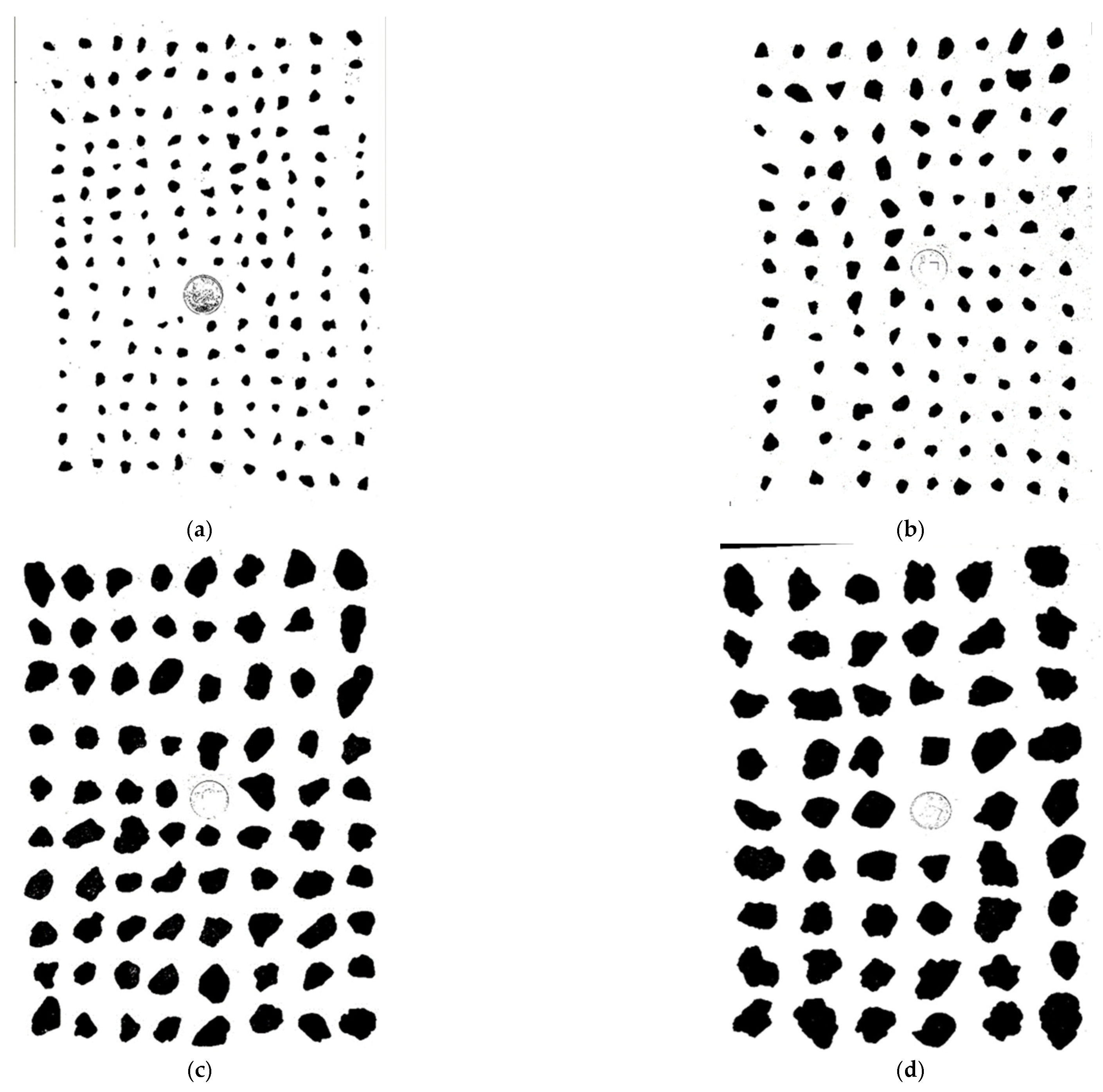
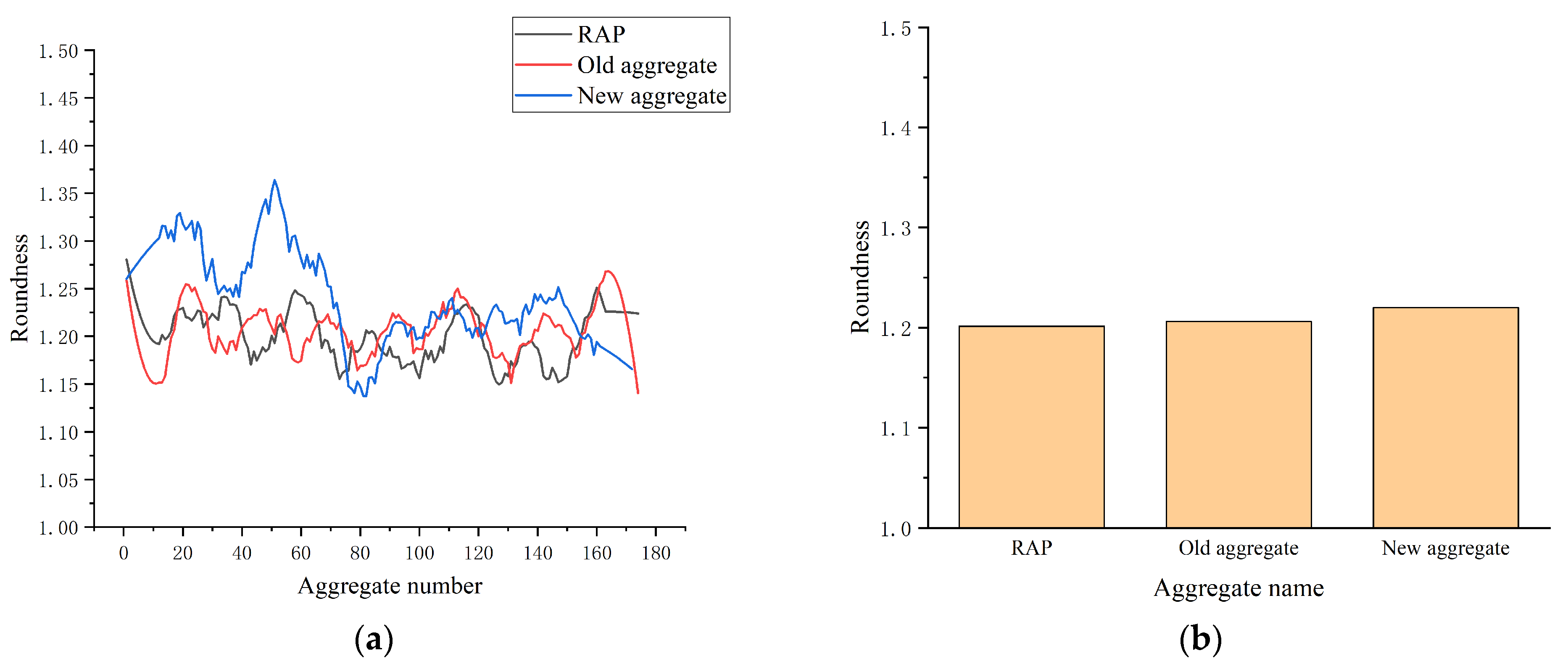
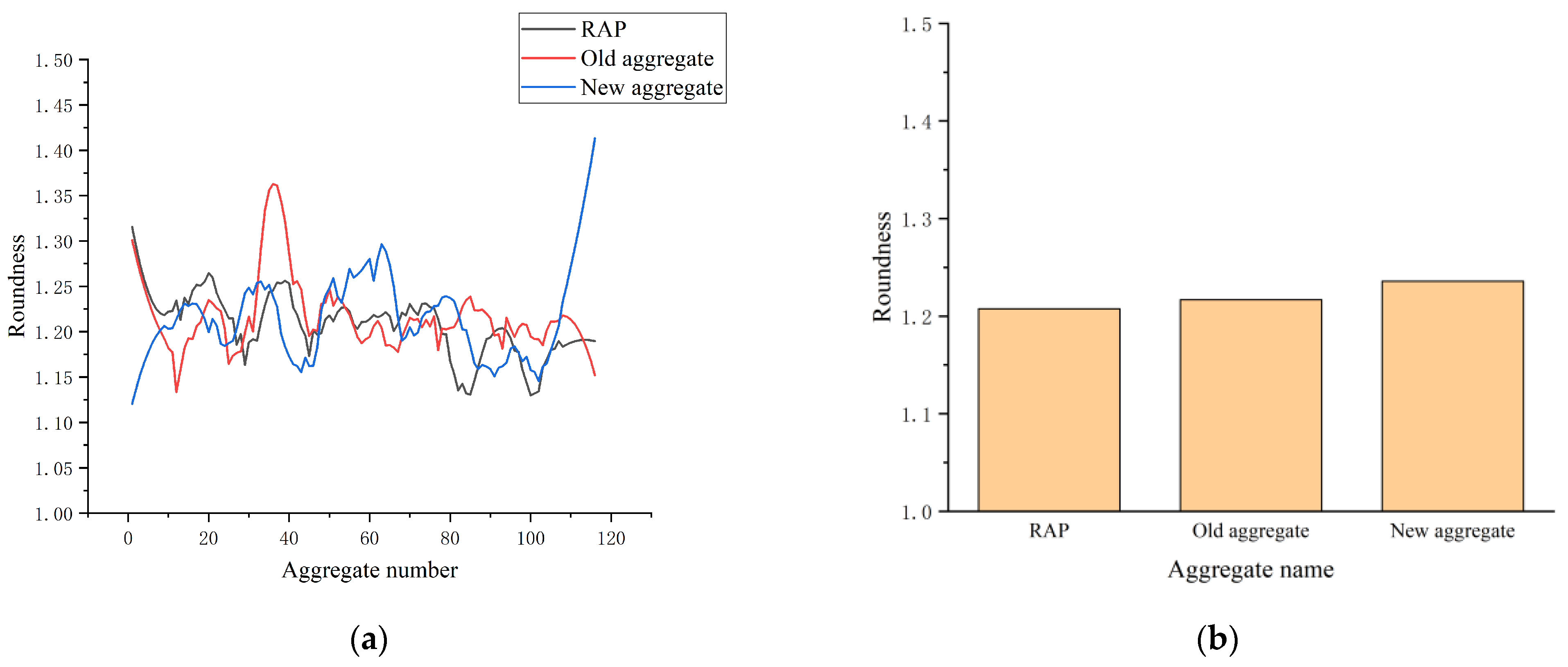
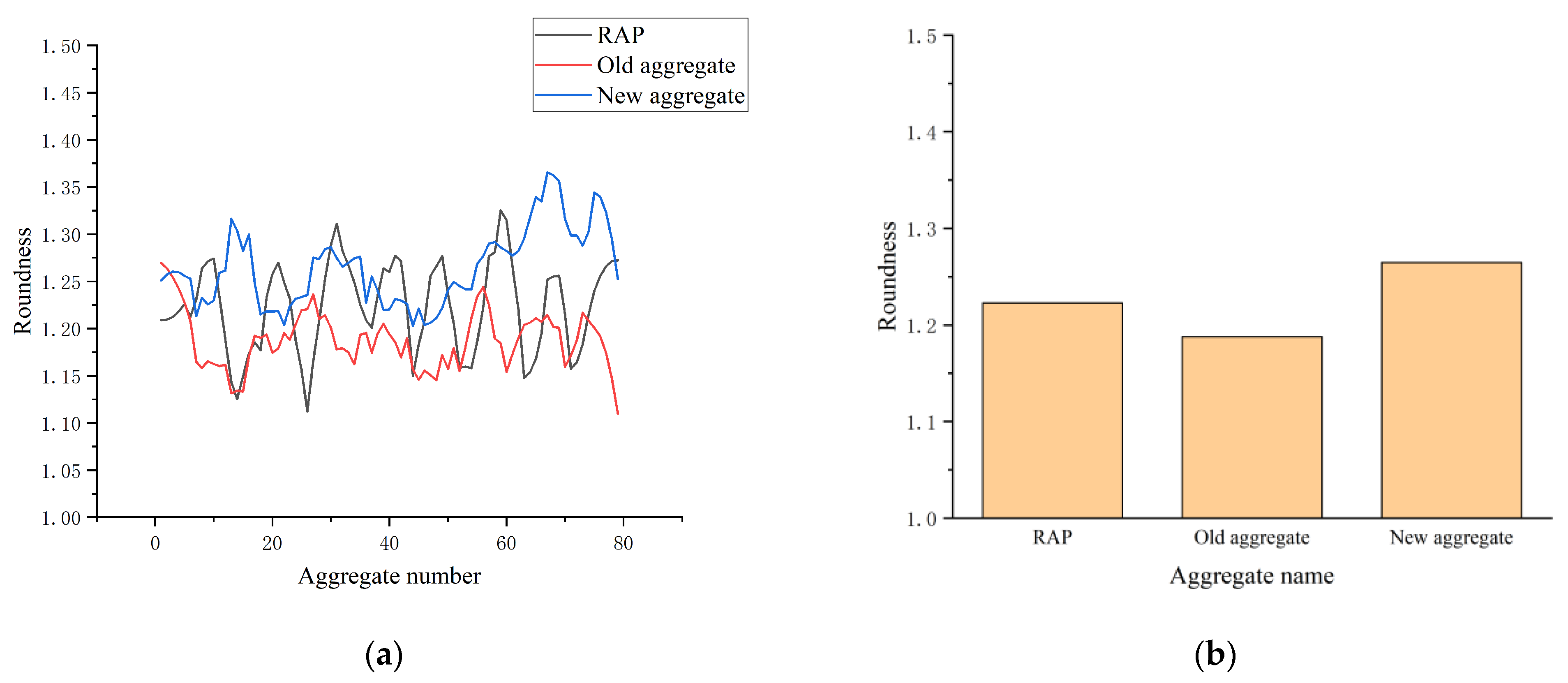
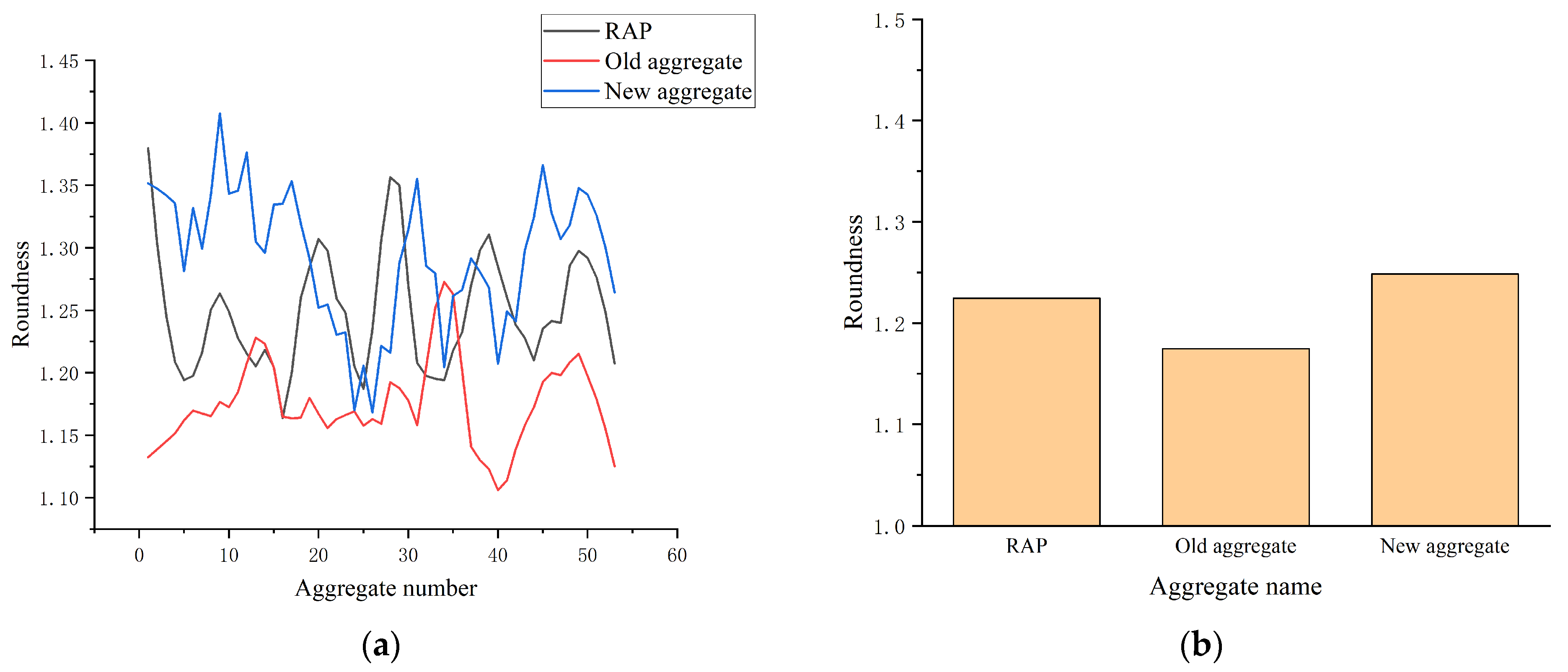
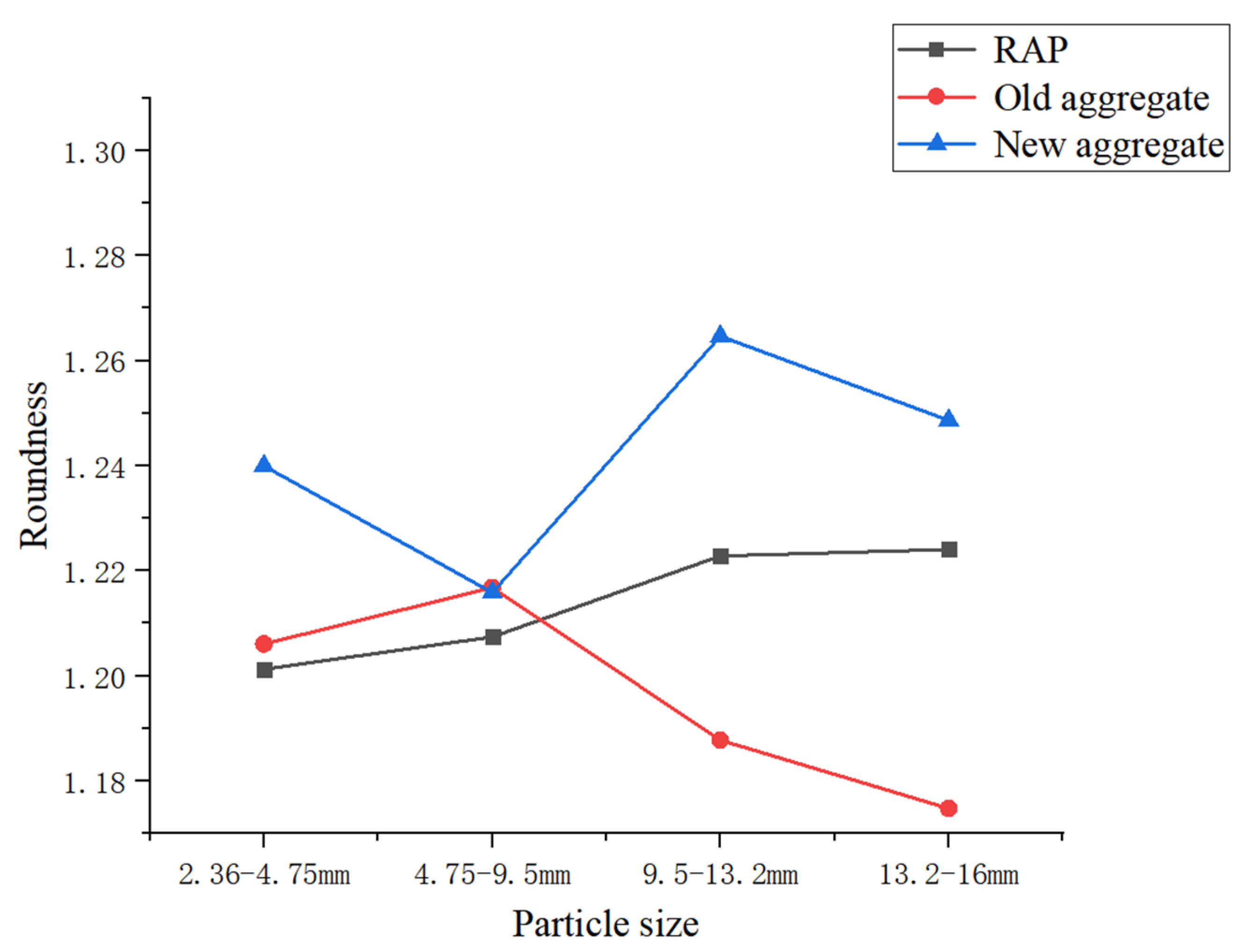
| Inspection Items | Needle Like (%) | Aggregate Crushing Value (%) | Abrasion Loss (%) | Water Absorption Rate (%) | Apparent Relative Density (~) | Adhesiveness (Degree) |
|---|---|---|---|---|---|---|
| measured value | 11.2 | 21.3 | 24.1 | 1.32 | 2.53 | 4 |
| standard value | >20 | >30 | >35 | >3.0 | >2.45 | >3.0 |
| Blending Type | Aggregate Type | ||||
|---|---|---|---|---|---|
| RAP Fineness Mixing Content (%) | 4.75~9.5 mm RAP Content (%) | 9.5~16 mm RAP Content (%) | New Aggregate Content (%) | Mineral Powder Dosage (%) | |
| Grading One | 10 | 20 | 0 | 67 | 3 |
| Grading Two | 10 | 10 | 10 | 67 | |
| Grading Three | 10 | 0 | 20 | 67 | |
| Blending Type | Grading One | Grading Two | Grading Three |
|---|---|---|---|
| Roundness | 1.2612 | 1.2291 | 1.1983 |
| Blending Type | 9.5~16 mm Aggregate Roundness | Flexural Strength/MPa | Bending Stiffness Modulus/MPa | |
|---|---|---|---|---|
| Grading One | 1.2612 | 2901 | 8.76 | 5528 |
| Grading Two | 1.2291 | 2865 | 8.55 | 5281 |
| Grading Three | 1.1983 | 2832 | 8.41 | 5017 |
| Blending Type | 9.5~16 mm Aggregate Roundness | Dynamic Stability (Times/mm) | |||
|---|---|---|---|---|---|
| 1 | 2 | 3 | Average Value | ||
| Grading One | 1.2612 | 2347 | 2394 | 2315 | 2352 |
| Grading Two | 1.2291 | 2235 | 2301 | 2259 | 2265 |
| Grading Three | 1.1983 | 2145 | 2103 | 2178 | 2142 |
| Blending Type | 9.5~16 mm Aggregate Roundness | Residual Stability (%) | Freeze–Thaw Splitting Strength Ratio (%) |
|---|---|---|---|
| Grading One | 1.2612 | 95.51 | 92.57 |
| Grading Two | 1.2291 | 93.43 | 91.33 |
| Grading Three | 1.1983 | 90.54 | 90.56 |
Disclaimer/Publisher’s Note: The statements, opinions and data contained in all publications are solely those of the individual author(s) and contributor(s) and not of MDPI and/or the editor(s). MDPI and/or the editor(s) disclaim responsibility for any injury to people or property resulting from any ideas, methods, instructions or products referred to in the content. |
© 2023 by the authors. Licensee MDPI, Basel, Switzerland. This article is an open access article distributed under the terms and conditions of the Creative Commons Attribution (CC BY) license (https://creativecommons.org/licenses/by/4.0/).
Share and Cite
Yi, Q.; Ru, N.; Liu, Z. Study on the Influence of Aggregate Roundness of Reclaimed Asphalt Mixture on Its Road Performance. Buildings 2023, 13, 2752. https://doi.org/10.3390/buildings13112752
Yi Q, Ru N, Liu Z. Study on the Influence of Aggregate Roundness of Reclaimed Asphalt Mixture on Its Road Performance. Buildings. 2023; 13(11):2752. https://doi.org/10.3390/buildings13112752
Chicago/Turabian StyleYi, Qigui, Nan Ru, and Zhaoting Liu. 2023. "Study on the Influence of Aggregate Roundness of Reclaimed Asphalt Mixture on Its Road Performance" Buildings 13, no. 11: 2752. https://doi.org/10.3390/buildings13112752
APA StyleYi, Q., Ru, N., & Liu, Z. (2023). Study on the Influence of Aggregate Roundness of Reclaimed Asphalt Mixture on Its Road Performance. Buildings, 13(11), 2752. https://doi.org/10.3390/buildings13112752





